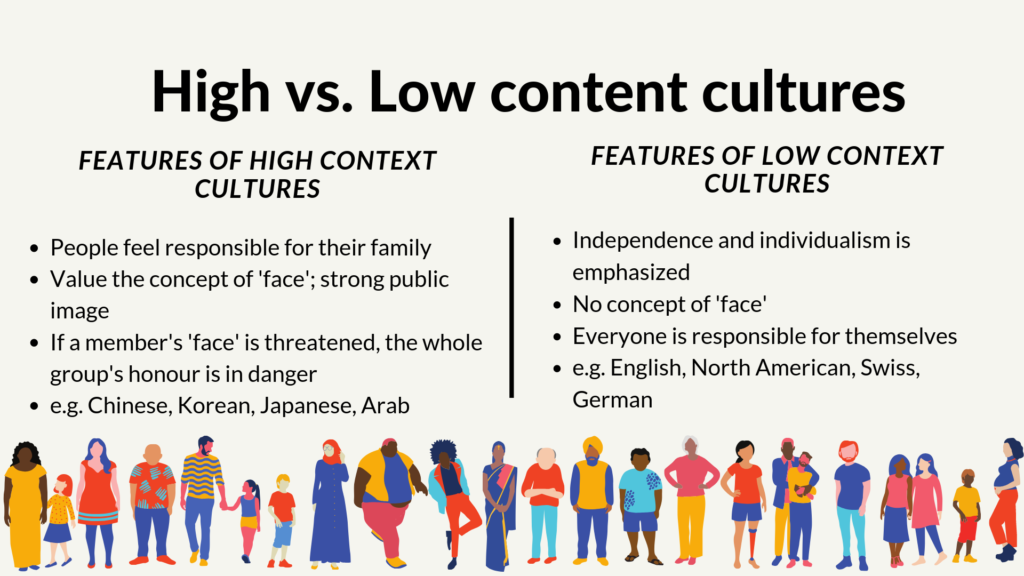Have you ever found yourself wondering why your colleagues from a different culture seem to communicate in a way that feels cryptic or overly direct? Or perhaps you’ve felt lost in a business negotiation where unspoken cues seem to carry more weight than explicit words? These are just a few examples of how cultural differences can impact our interactions, particularly when it comes to communication styles. At the core of these differences lies the concept of high- and low-context cultures, a framework that sheds light on how individuals understand and interpret information within their cultural context.

Image: www.coachingexpatriates.com
Understanding the nuances of high and low context cultures can be immensely valuable in today’s interconnected world. This knowledge empowers us to navigate diverse interactions with greater sensitivity and effectiveness, fostering stronger relationships and achieving better outcomes in both business and personal spheres.
Delving into the Tapestry of High- and Low-Context Cultures
The concept of high and low context cultures was first introduced by anthropologist Edward T. Hall in the 1970s. It describes how individuals rely on either explicit or implicit communication patterns within their social systems. In high-context cultures, meaning is often derived from implicit cues, shared understandings, and nonverbal communication. Think of it as a shared cultural code, where unspoken gestures, facial expressions, and even silence can carry significant weight in conveying information. On the other hand, low-context cultures favor explicit communication, where meaning is primarily expressed through clear and direct language.
High-Context Cultures: A World of Shared Meanings
Imagine yourself walking into a bustling marketplace in a high-context culture. You might notice a blend of vibrant colors, aromas filling the air, and a symphony of sounds. However, amidst the chaos, there’s a sense of unspoken understanding—a shared cultural knowledge that binds the participants together. In high-context cultures like Japan, China, and many Arab countries, communication relies heavily on implicit cues.
Here are some key characteristics of high-context cultures:
- Emphasis on nonverbal communication: Gestures, facial expressions, and even silence carry substantial meaning.
- Importance of relationships: Building trust and rapport is paramount before engaging in business or personal matters.
- Value placed on long-term relationships: Trust and loyalty are highly valued, and relationships often extend beyond the immediate transaction.
- Implicit communication style: Meaning is often conveyed through subtle nuances and shared understandings.
- Focus on context: Factors such as social status, relationships, and history play a significant role in interpreting messages.
- Prefer indirect communication: Direct confrontation is often avoided, and subtle hints or suggestions are preferred.
Navigating the Explicit World of Low-Context Cultures
In contrast, low-context cultures like the United States, Germany, and Scandinavia, rely on explicit communication. Here, words are primarily used to express meaning, and clear, unambiguous language is highly valued. Imagine a formal meeting in a low-context culture. You might expect a structured agenda, a clear presentation of facts, and a direct approach to problem-solving.
Here are some defining traits of low-context cultures:
- Direct communication: Expressing ideas clearly and concisely is highly valued.
- Emphasis on written communication: Contracts, agreements, and other written documents play a crucial role.
- Value placed on individual achievement: Personal accomplishments and individual responsibility are highly regarded.
- Short-term relationships: Business transactions and interactions are often focused on immediate goals and efficiency.
- Focus on individual responsibility: Individuals are expected to take ownership of their actions and responsibilities.
- Prefer direct communication: Confrontation is considered more acceptable than avoiding it, and solutions are often sought through direct discussion.

Image: learningandteaching-navitas.com
Bridging the Cultural Divide: Building Understanding and Harmony
Recognizing the differences between high and low context cultures is the foundation for fostering impactful interactions across cultural boundaries. By understanding these distinct communication styles, we can cultivate empathy and effectively navigate diverse communication contexts.
Here’s how you can foster greater understanding and build bridges across different cultures:
- Be mindful of nonverbal cues: Pay attention to gestures, facial expressions, and body language, even if you’re unfamiliar with the specific cultural interpretations.
- Listen actively: Actively listen to understand the speaker’s perspective, even if you don’t fully agree.
- Ask clarifying questions: Don’t hesitate to ask for clarification if you are unsure about the meaning of a message.
- Be patient and respectful: Remember that cultural differences can lead to misunderstandings, so approach conversations with patience and respect.
- Use visual aids: Images, diagrams, and other visual aids can be especially helpful in high-context cultures, where nonverbal communication plays a larger role.
Expert Insights: Gaining Knowledge from the Masters
Renowned experts in intercultural communication offer valuable insights for navigating these cultural differences. Dr. Erin Meyer, author of “The Culture Map”, stresses the importance of bridging the “cultural gap” through active listening and open communication. She advocates for recognizing the different ways cultures process information, interpret time, and approach decision-making.
Additionally, Dr. Geert Hofstede, whose work on national cultural dimensions is widely recognized, emphasizes that cultural differences are not simply about manners or customs. They shape how people think, behave, and interact in both business and personal spheres.
High And Low Context Cultures
Embracing the World of Cultural Diversity
Understanding the concept of high and low context cultures is more than just academic knowledge— it’s a key to navigating the complex and interconnected world we live in. By embracing the nuances of different communication styles, we cultivate empathy and foster meaningful relationships across cultures. It’s about recognizing the beauty of cultural diversity and appreciating the unique ways people connect and communicate.
So, the next time you encounter someone from a different cultural background, take a moment to consider their cultural context. Embrace the opportunity to learn, adapt, and build bridges of understanding. Together, we can create a world where cultural differences are celebrated and harnessed to foster collaboration, innovation, and a deeper sense of belonging.






